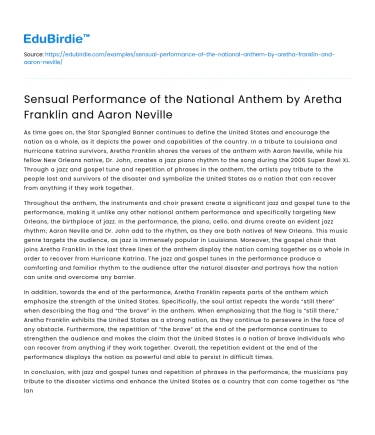As time goes on, the Star Spangled Banner continues to define the United States and encourage the nation as a whole, as it depicts the power and capabilities of the country. In a tribute to Louisiana and Hurricane Katrina survivors, Aretha Franklin shares the verses of the anthem with Aaron Neville, while his fellow New Orleans native, Dr. John, creates a jazz piano rhythm to the song during the 2006 Super Bowl XL. Through a jazz and gospel tune and repetition of phrases in the anthem, the artists pay tribute to the people lost and survivors of the disaster and symbolize the United States as a nation that can recover from anything if they work together.
Throughout the anthem, the instruments and choir present create a significant jazz and gospel tune to the performance, making it unlike any other national anthem performance and specifically targeting New Orleans, the birthplace of jazz. In the performance, the piano, cello, and drums create an evident jazz rhythm; Aaron Neville and Dr. John add to the rhythm, as they are both natives of New Orleans. This music genre targets the audience, as jazz is immensely popular in Louisiana. Moreover, the gospel choir that joins Aretha Franklin in the last three lines of the anthem display the nation coming together as a whole in order to recover from Hurricane Katrina. The jazz and gospel tunes in the performance produce a comforting and familiar rhythm to the audience after the natural disaster and portrays how the nation can unite and overcome any barrier.
Save your time!
We can take care of your essay
- Proper editing and formatting
- Free revision, title page, and bibliography
- Flexible prices and money-back guarantee
In addition, towards the end of the performance, Aretha Franklin repeats parts of the anthem which emphasize the strength of the United States. Specifically, the soul artist repeats the words “still there” when describing the flag and “the brave” in the anthem. When emphasizing that the flag is “still there,” Aretha Franklin exhibits the United States as a strong nation, as they continue to persevere in the face of any obstacle. Furthermore, the repetition of “the brave” at the end of the performance continues to strengthen the audience and makes the claim that the United States is a nation of brave individuals who can recover from anything if they work together. Overall, the repetition evident at the end of the performance displays the nation as powerful and able to persist in difficult times.
In conclusion, with jazz and gospel tunes and repetition of phrases in the performance, the musicians pay tribute to the disaster victims and enhance the United States as a country that can come together as “the land of the free and the home of the brave”.






 Stuck on your essay?
Stuck on your essay?

